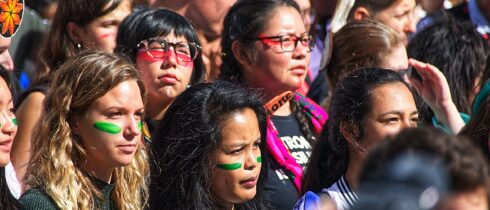

Time to reverse the debt trap with the Global South
Behind the smoke and mirrors of climate finance
While the international community works to put conquest and colonialism in the past, the Global South continues to be subject to neocolonial mechanisms that exacerbate the debt and climate crises. Achieving climate and economic justice requires structural reparations, countering debt generation traps and coordinated action. The first step for those who owe the climate debt is to get real about it, writes Carola Mejia from LATINDADD.
This article was originally published in META, the EEB news channel.
People rarely question the financial debt of the Global South, while shared efforts to deal with the climate debt of the Global North rarely go further than roundtable talks. For the status quo to change, the global climate finance landscape will need to be reshaped in a big way. The new report by LATINDADD outlines several promising alternatives.
What goes around, comes around
Despite their natural and cultural wealth, most Global South countries are not at their best. They have to deal with poverty, inequality, and the inability to get basic social services daily. The pandemic and its uneven recovery have shown even more weak spots and made the gap between rich and poor within and between countries even bigger.
And Russia’s war against Ukraine aggravated food and energy poverty while making other crises even more acute. These issues shed light on a system where a large share of the global population faces bleak prospects in the turbulent future. This happens as we keep financing fossil fuels, with their subsidies exceeding climate finance eightfold.
At this very time, the low- and middle-income countries that have contributed little to the climate crisis suffer the worst impacts. Last year, Pakistan faced floods affecting 33 million people, displacing 8 million and causing $40 billion in economic losses, while India lived through record heatwaves, disrupting whole industries.
The story goes beyond the displacement of burdens. The drought that dried up the Yangtze River destabilised global lithium supply chains, an essential material in the so-called “race to net zero“. And thousands of migrants displaced by typhoons in the Philippines are another reminder of the climate migration that will impact millions over the next decades.
Doing business as usual for climate finance means that some things will improve while entrenching dependencies and failing to resolve the roots of the crisis. Sooner or later, the outcomes will not leave anyone untouched.
More money, same old story
The rise of extractivism and overconsumption have driven the global dependency on fossil fuels in the name of “economic growth”. However, this growth came with outcomes that are hard to price: vast inequalities, resource depletion and a treadmill of crises. The international financial system keeps adding fuel to the fire. Inefficient, undemocratic and unfair, it serves a few, perpetuating the dependence on others.
Reports by Eurodad, CAN and Debt Justice highlight clear links between the climate and the debt crises, and the recent study by LATINDADD dive deep into this relationship.
An obvious outcome of servicing debt is a constraint on national spending. In 2021, debt service in Latin America and the Caribbean (LAC) represented 91% of total social spending. In the same year, the lowest-income countries spent more than five times more on external debt payments than on climate action.
Greater debt pushes the Global South countries to keep investing in extractive sectors to guarantee debt service payment, sacrificing social priorities and climate targets. The higher borrowing costs also mean greater financial risks and higher vulnerability to economic, climate and other disruptions while limiting local economic capabilities.
On top of this, public international climate finance, under the unfulfilled USD 100 billion goal, is creating more debt. In 2020, 72% of bilateral and multilateral climate finance has been delivered through loans to the Global South countries, leading to rising in indebtedness, with a higher share of loans among LAC (81%) and Asia (88%). Expensive non-concessional loans also represent most of the climate finance delivered by the multilateral development banks.
The vicious cycle with no way out
The way the global economy and financial system work nurtures all kinds of divides, a fact largely ignored in bold finance commitments and the design of the new climate schemes.
Many countries in LAC and Asia suffering pressing sustainability challenges are meanwhile considered “middle-income”, which limits their access to non-reimbursable or concessional finance, and debt treatment initiatives.
For countries grappling with economic and climate disruptions, finance to support recovery comes with more debt, shrinking fiscal opportunities and chances for a better future. Popular financial mechanisms, such as green bonds, also mean more debt to the country.
The recent rise of interest rates aimed to contain inflation has led to the rising cost of debts. Local currency depreciation increased the burden of external debt by undermining the balance of payments, widening the fiscal gap, and igniting more borrowing.
Debt becomes a trap where the only solution is more debt. This flawed system can’t be fixed with more of the same.
Rebooting international climate finance
Climate debt is real: Global North owes structural reparations to the Global South for centuries of ecologically unequal exchange. The time has come for a major change in how we approach climate finance, and well-elaborated proposals abound.
From debt relief to moratorium clauses and debt-for-climate swaps, it is time for more mechanisms that account for climate debt to be adopted at scale. We need climate finance that does not create debt but builds capacities and prevents new dependencies. This is particularly critical for adaptation and loss-and-damage related finance.
Debt resolution under the UN and a new emission of Special Drawing Rights (SDRs) to help finance the Sustainable Development Goals are examples of mechanisms that could build on available experience. Making good use of those proposals would need to be accompanied by a fair and inclusive reform of the international financial architecture to align with universal human rights and shared sustainability pursuits.
Structural issues like poverty, hunger and inequality are direct outcomes of the broken system, which prioritises profit over justice and is shortsighted at the cost of our future. We need a system that will serve people and nature in the long run.
Restoring justice will not solve the mounting multicrisis overnight, but it will get us moving in the right direction. As our time runs out rapidly, it is urgent to put life itself and the lives of those who suffer most, and not profit, at the centre of our decisions.
- Read more about the promises and risks of alternative climate finance in the CLIMATE CRISIS, DEBT AND RECOVERY IN A CONTEXT OF MULTIPLE CRISES report.
- Read #ClimateOfChange report “Beyond panic? Exploring climate mobilities in Guatemala, Senegal, Kenya and Cambodia“.














